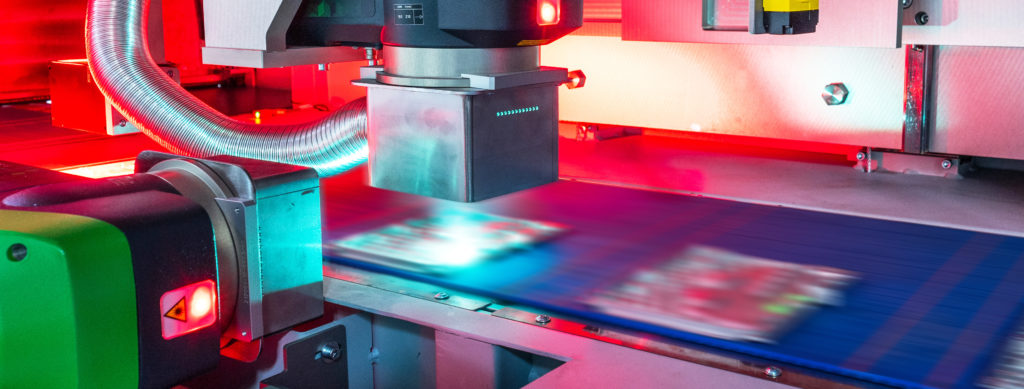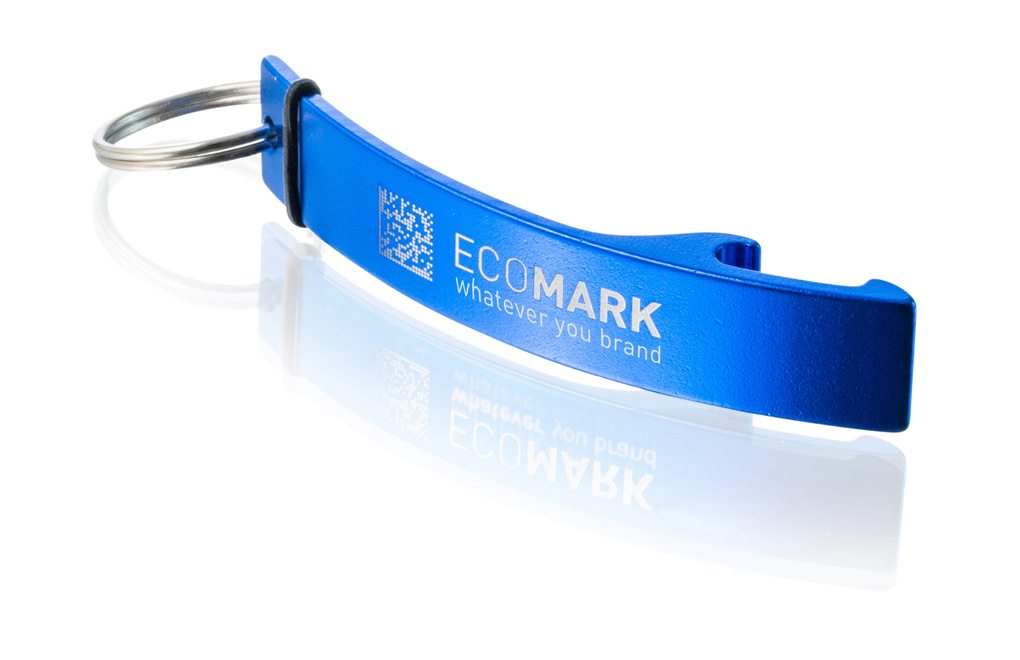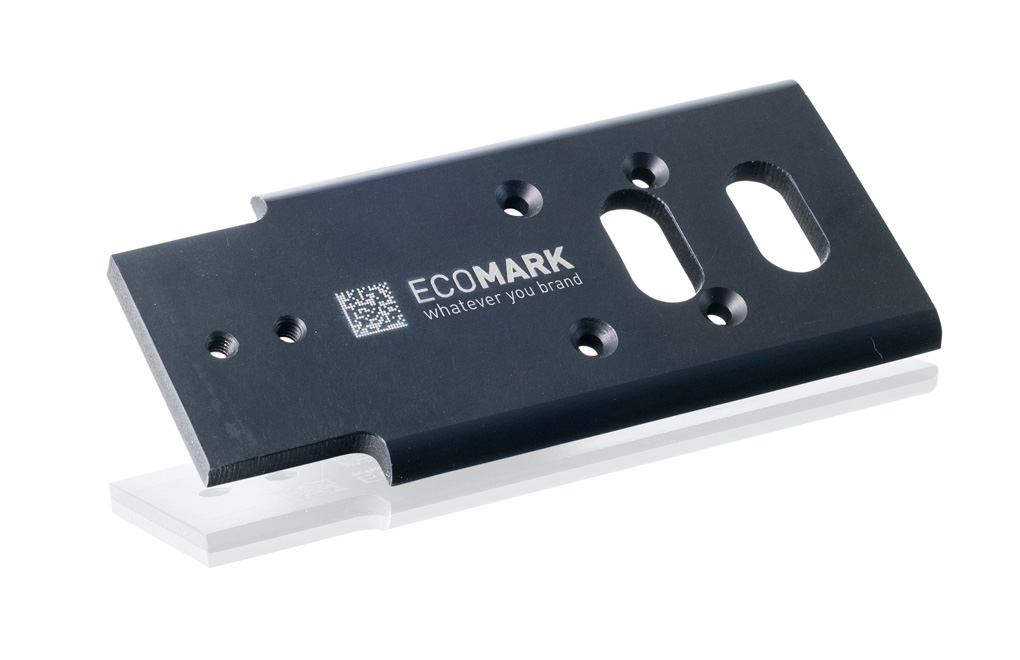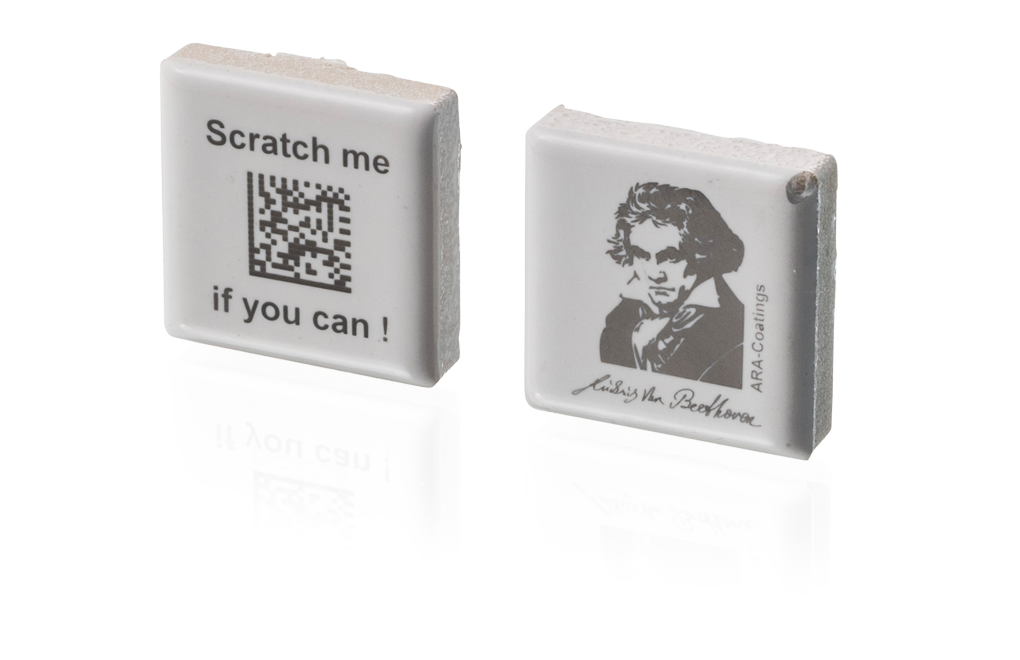
SMALL CODE BIG: Laser DMC code WITH ECOMARK -
AUTOMATED, EFFICIENT AND PERMANENTLY RELIABLE
The data matrix code - DMC for short - belongs to the optoelectronic 2D codes and was already developed at the end of the 1980s for marking products. Data matrix codes are standards-based according to ISO 16022 and are used in industry as an alternative to the QR code and the barcode.
For many years, data matrix marking and coding was done using ink jets. Today, laser marking or laser embossing of the matrix is state of the art for most materials and users. Data matrix markings can be lasered onto almost all materials with a marking laser. Whether metal, plastic, glass, wood or leather. This opens up an almost infinite range of applications in industry.
THE DATA MATRIX CODE

- DMC MARKING - A LOT OF DATA IN A VERY SMALL SPACE
The matrix of codes contains information such as uniquely identifiable, forgery-proof serial numbers on pharmaceutical packaging, manufacturer identifiers for components, logos on original spare parts, vehicle identification numbers, production data and safety certificates for devices and much more. The square or rectangular code can be applied in different sizes from 10×10 modules. The great advantage of data matrix codes: You can encode a much higher data density in the matrix on a smaller area than with a barcode, for example. In addition, the data can be easily read by any 2D code reader, regardless of the position of the lasered parts. An important point is the error tolerance of up to 30 percent: if the surface of the matrix is damaged, the data information of the code can still be recognised. Here, too, 2D codes are superior to linear, one-dimensional barcodes.
In the matrix, the data are encoded in the form of box-like differently coloured, mostly black and white areas. Since in principle even a low contrast is sufficient for readability, even colour designs are possible depending on the application. The large amount of information that can be accommodated on the compact data matrix, the efficiency, variety and flexibility of use and the practical advantages of data matrix marking in modern industrial production processes are convincing more and more users from a wide range of sectors and industries. There are good reasons why laser marking technology is becoming more and more popular as a solution for identification.
Laser marking is more accurate and efficient than traditional inkjet printing methods. In addition, the laser does not require any consumables compared to the inkjet, so there are no costs for ink and changeover times or cleaning costs. Marking lasers are also non-contact, low-wear and low-maintenance and, above all, extremely fast, so that marking can be smoothly integrated even into high-speed production processes.
DMC APPLICATIONS - A NEVER-ENDING STORY
Data matrix codes are extremely versatile - another decisive advantage over barcodes. Whether it is a question of marking documents or cards with access authorisations, for franking letters and parcels, for incoming and outgoing goods inspection, for controlling production processes and for quality assurance, as well as for the permanent laser marking of electronic components, pharmaceutical packaging, filigree medical precision instruments or heavy castings.
One of the main benefits of data matrix marking is traceability. DMC-marked devices, products and components can be traced back at any time via the data matrix to where they originated, where they were manufactured, processed, traded, purchased and used, right through to disposal. This complete traceability covers the entire production and supply chain in both directions: from the manufacturer to the user and vice versa. If, for example, there are quality or safety problems with appliances or if it turns out that medicines are contaminated, recall measures can be implemented. On the other hand, labelling also offers manufacturers protection against plagiarism and unjustified liability claims in the case of counterfeit products.

TRACEABILITY AND ANTI-COUNTERFEITING
Especially in the automotive industry, DMC laser embossing is the method of choice today to ensure traceability and protection against counterfeiting. Especially the traceability of automotive parts is essential, because it enables compliance with high quality standards. For safety-relevant components, it is an absolute must and regulated by law.
By means of laser marking, data matrix codes can be precisely and permanently lasered on a wide variety of surfaces and materials. Even complex shaped castings or workpieces with uneven, rough surfaces, such as milled parts, can be easily marked with the laser. The spectrum of different lasers enables this wide range of applications. Mostly CO2 or fibre lasers are used, but also UV, Green or YAG lasers. Different laser processes are suitable for DMC laser embossing, such as laser engraving, colour or material removal, annealing, colour change/foaming and carbonisation.

DMC CODE LASER WITH ECOMARK
Due to the diverse stresses to which the components in the car are exposed, the DMC codes must be uncompromisingly reliable and remain so even under extreme conditions. To achieve this, the laser marking must be absolutely stable and permanently resistant to mechanical and chemical stresses during production and operation. The marking must reliably withstand e.g. surface treatment or painting, abrasion, lubricants or road salt etc. and be resistant to external influences such as light, heat, cold and water.
EcoMark laser markers meet the highest quality requirements for DMC laser marking and offer convincing efficiency advantages in industrial use. Fast code adaptations and the integration of EcoMark laser marking machines into existing production systems enable dynamic on-the-fly laser marking of all workpieces and components. Precise and permanently reliable.
EcoMark also offers process-integrated code grading (click here for a link to the CodeGrading subpage on eco-mark.de) in accordance with applicable ISO/IEC standards, so that the entire process can be automated in one machine. Code grading is a system with which Data Matrix codes are checked for quality and readability in order to detect possible errors as early as possible and thus prevent further-reaching problems in production and product use from the outset. Only flawless codes can be read reliably and without errors by all readers used in the further supply chain or in use. Therefore, it is important to permanently monitor the quality of the codes already in the production process.
To ensure the readability of a Data Matrix code, there are marking guidelines and standards, for example for the automotive industry, the electronics industry, medical technology and the pharmaceutical industry. Essentially, this involves meeting the requirements of ISO 16022, which defines the structure, and ISO 29158, which assures EcoMark.
EXCITING PROSPECTS:
DMC LASER MARKING HAS A FUTURE
The potential of DMC marking is far from exhausted. Areas of application with a great future are, for example, control codes for automated production in Industry 4.0. But applications in the consumer goods sector are also increasingly coming into view. For example, the information in DMC codes can also be used for the increasingly "smart" and networked household appliances, e.g. to control functions, facilitate operation or make services more convenient.
As a specialist for intelligent, forward-looking solutions in the field of laser marking, EcoMark always has its finger on the pulse of developments and is able to develop fast and custom-fit solutions for all conceivable applications. We would be happy to discuss your requirements with you.

